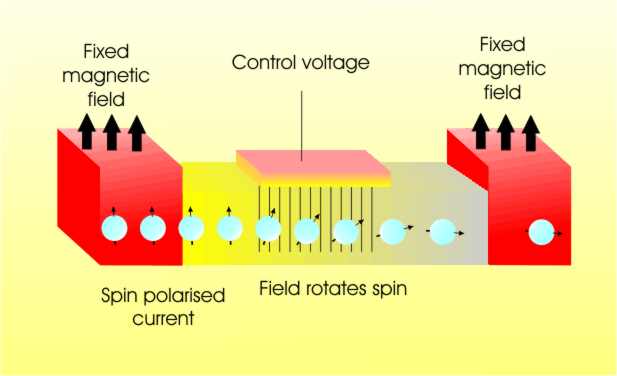| Spintronics |
| Written by Editor | |||||
| Sunday, 30 August 2009 | |||||
Page 4 of 4
Beyond MTJsCurrently MTJs and spin valves are the only commercial applications of spintronics but there is much more in the pipeline. Most of the proposed devices have one problem – no-one has managed to make them work as yet but it’s early days. The most conventional, if this is the right word, of the speculative applications is the spin transistor. This uses the same three-layer structure of the spin valve but now the layer between the ferromagnetic layers is a semiconductor channel. The ferromagnetic source and drain are both pinned in the same fixed direction. The source produces a spin-polarised current that the drain is happy to accept with the result that the device has a reasonably low resistance to current flow. A metal pad on the semiconductor channel acts as a gate to the current flow by applying an electric field. This rotates the spins as they pass along the channel. The result is that as the gate voltage is changed the spin polarisation changes and becomes less compatible with the polarisation direction needed by the drain. Hence as the gate voltage increases the drain current decreases and we have a transistor, a spin field effect transistor or SFET. At the moment no-one has succeeding in building an SFET. The reason is that there are difficulties in making spin currents pass from a ferromagnetic material into a semiconductor. One solution to the problem is to use a semiconductor which itself shows ferromagnetic properties, i.e. a magnetic semiconductor. These materials exist and can be used to build a gateable ferromagnetic. A small voltage changes a bar of the material from magnetic to non-magnetic. At the moment, though, we still don’t have a spin-based transistor. Why would be want one? The theory is that spins can be flipped with far less power and far faster than a standard FET can control non-spin-polarised currents. Hence SFETs will be more efficient and able to work at much higher frequencies than FETs – but these are currently only theoretical advantages. Quantum ComputersThe most speculative ideas for making use of electron spin are, of course, quantum computers. The technological problems to be overcome in this area are all to do with how long a spin polarisation can be maintained. This is also important to the functioning of devices such as MTJs and SFETs but they become particularly acute when you consider quantum computing.
A spintronic transistor works by rotating the spin using an electric field In a quantum computer we still use a system that has two states to represent 0 or 1. In a non-quantum computer we can always say that a memory location is in one of the states with certainty – in fact we use a lot of engineering to make sure that this is the case! In a quantum computer, however, quantum bits or qubits can be in both 0 and 1 states at the same time – they can be in a superposition of the 0 and 1 states. It is this superposition state which allows a quantum computer to work with a large range of values in parallel and to select the values that satisfy some condition. The big problem is coherence. The qubits tend to interact with the surrounding environment and this makes them fall out of the superposition state and become a 1 or a 0 with 100% certainty. This is called “decoherence” and it is responsible for errors in quantum computing. Quantum computers based on electrons charged to represent bits tend to dissipate or “decohere” in a few picoseconds (1 picosecond= 10^-12 seconds) and only work at very low temperatures. Spin offers the prospect of building quantum computers that can maintain coherence for a lot longer and at more reasonable temperatures. Currently experimenters have maintained spin coherence for nanoseconds, i.e. a 1000 time longer at room temperature. The reason is that spin superposition states are inherently more stable. You can think of it a bit like the stability that a gyroscope provides. A gyro always points in the same direction and if you try to make it change its direction it resists. A spinning electron is a bit like a gyro but to understand the way that it behaves in detail you have to use quantum mechanics. A quantum spin computer would use spin up for a 1 and spin down for a zero. The superposition state representing both a 0 and a 1 at the same time is a spin in the horizontal direction. According to quantum mechanics such an orientation is a combination of spin up and spin down and this is far more stable than other quantum electronic states. What is often overlooked in such rarefied discussion is that spin-based computers can be built that are conventional in their operation and don’t make use of superposition states. This opens up the possibility of logic gates at the size of a few atoms processing small numbers of electrons carrying data as a pattern of spins. Using lasers and sophisticated semiconductor technologies it has been possible to create spin packets – groups of electrons all with the same spin – and transmit them 100 microns or more without losing their spin orientation. This is comparable to the size of features used in current microchips and opens up the possibility of using spin to code data in integrated circuits. Current research is focusing on improving MRAMs and making them cheaper and on creating new ferromagnetic semiconductors and spin devices. This is one of the growth areas in technology at the moment and there is clearly a lot of money to be made. Let’s hope the bubble doesn’t burst before we see practical outcomes in terms of consumer products.
|
|||||
| Last Updated ( Sunday, 30 August 2009 ) |

